Wall Pilates is a game-changer for your fitness. It offers a safe and supportive way to boost your strength, balance, and flexibility—all you need is a wall and a mat. This low-impact exercise reduces fall risks, enhances your core stability, and improves your posture without straining your joints. Plus, it promotes mental well-being through mindful movements. If you’re curious about how to fit Wall Pilates into your daily routine, there’s so much more to explore.
Key Takeaways
- Wall Pilates enhances stability and balance, significantly reducing fall risks for seniors during workouts.
- This gentle, low-impact exercise improves flexibility and builds strength without straining joints.
- Practicing Wall Pilates promotes mental well-being by reducing stress and enhancing focus through mindful movement.
- The wall provides essential support, allowing seniors to safely engage in classic Pilates exercises while maintaining proper form.
- Group classes foster social connections, combating isolation and promoting a sense of community among participants.
Understanding Wall Pilates
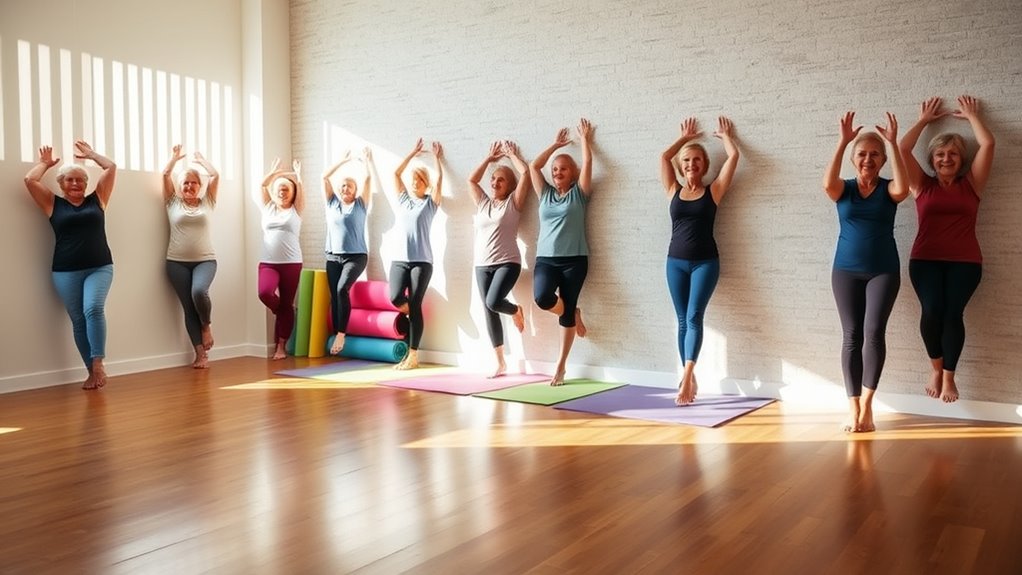
While many traditional Pilates exercises can be challenging, Wall Pilates offers a supportive alternative that makes it accessible for everyone, especially seniors. This method involves performing classic Pilates moves against a wall, which provides stability and resistance. You only need a wall, eliminating the need for special equipment. Sessions typically last 45 minutes to an hour, similar to traditional Pilates. The wall mimics the foot bar of a reformer, enhancing your strength and alignment. Focusing on core engagement, Wall Pilates improves posture while activating muscles through controlled movements. It’s beginner-friendly and adaptable, catering to all fitness levels. Additionally, the practice is low impact, making it gentle on joints and muscles, which is particularly beneficial for seniors. Incorporating gentle stretching into your routine can further enhance the effectiveness of Wall Pilates. With its growing popularity—over 56.4 million views on TikTok—Wall Pilates is establishing itself as a go-to workout for many. Regular practice can lead to improved mental clarity, which is essential for overall wellness and personal growth. Furthermore, engaging in low-impact exercises like Wall Pilates can significantly improve flexibility and strength in seniors. Many individuals find that advanced technology can also enhance their fitness experience by providing additional support and guidance during workouts. Additionally, practicing core engagement is crucial for maintaining stability and balance, which are vital as we age.
Key Benefits for Seniors
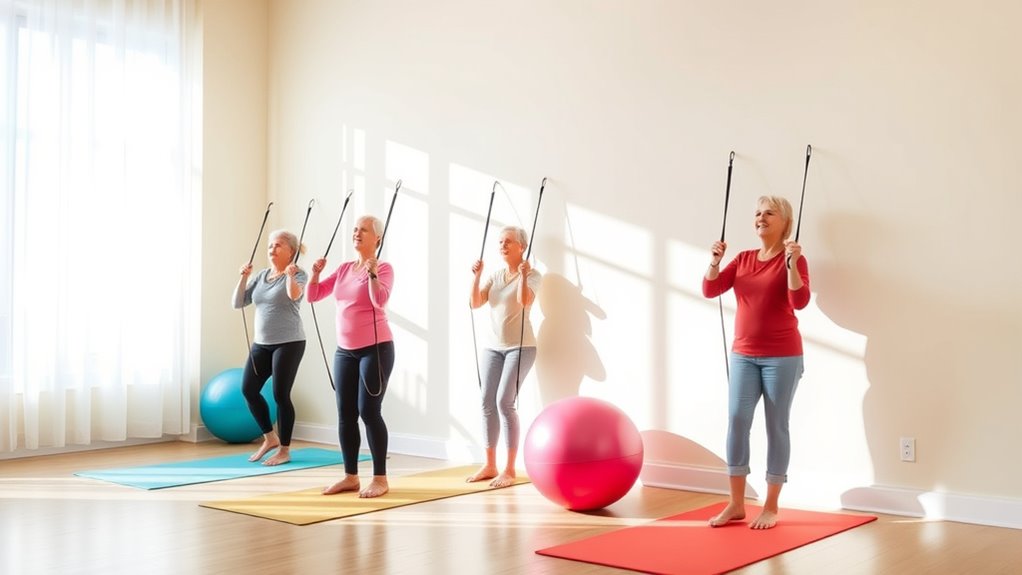
Wall Pilates offers a range of key benefits for seniors, making it a valuable addition to their fitness routine. You’ll notice improved balance and stability, as the wall provides support and reduces fall risks. These exercises enhance flexibility and help build strength without straining your joints, which is essential for maintaining independence. Plus, they’re low-impact, making them perfect for those with arthritis or joint issues. Regular practice can also improve your posture and alignment, relieving discomfort. Additionally, Wall Pilates acts as a stabilizing partner, allowing you to exercise with greater confidence and safety. On top of physical health, Wall Pilates promotes mental well-being by reducing stress, enhancing focus, and boosting mood. Engaging in group classes fosters social connections, helping you feel less isolated while enriching your overall quality of life. Furthermore, participating in these exercises can help you develop a growth mindset, which is crucial for enhancing resilience and thriving in later years. Incorporating community events into your routine can further strengthen your support network and encourage continued participation in wellness activities. Moreover, many seniors find that camping locations provide a great opportunity to enjoy nature, which can enhance their overall well-being. Notably, engaging in regular physical activity can also help mitigate brain fog effects, particularly for seniors who may be experiencing cognitive decline. Additionally, maintaining a strong support network is essential for emotional health, providing encouragement and motivation throughout your fitness journey.
Core Strength and Stability Through Wall Exercises
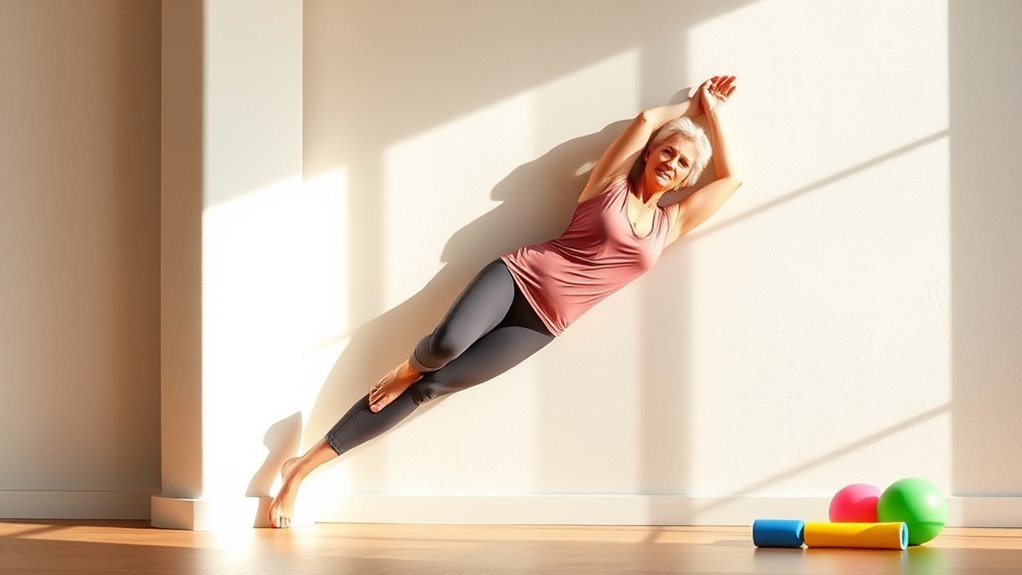
Core strength is crucial for maintaining stability and balance as you age, and engaging in Wall Pilates exercises effectively targets these muscles.
Movements like Wall Roll Downs and Wall Push-Ups engage your core while providing support from the wall. This setup allows you to strengthen your abdominal muscles, which is essential for a stable body center. Additionally, Wall Sits and Wall Leg Lifts challenge your balance and lower body strength simultaneously, ensuring thorough core engagement. The wall’s support means you can focus on your form without the risk of falling, making these exercises safe and accessible. Regular practice not only maintains muscle mass but also enhances your overall stability, reducing the risk of falls as you age. This is particularly important because wall exercises adapt traditional Pilates moves for added stability. Engaging in these exercises can also improve your hearing health, which is vital as age-related conditions may affect balance. Moreover, developing core strength can significantly help in managing toilet running issues, leading to a more efficient and sustainable household. Additionally, incorporating RMD strategies into your fitness routine can maximize the benefits of your overall health as you age. Furthermore, understanding the emotional dysregulation associated with age-related challenges can enhance your overall workout experience. Moreover, the practice of mindful decluttering in your environment can further enhance your focus during workouts, creating a more tranquil space for your fitness journey.
Enhancing Posture and Alignment
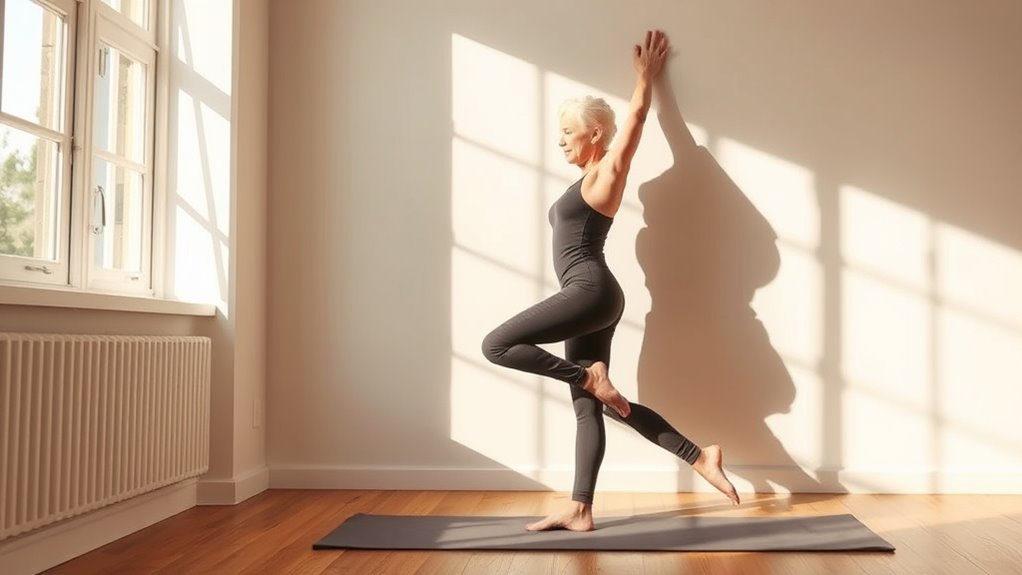
As you age, maintaining good posture becomes essential for overall health and well-being. Wall Pilates specifically targets spinal alignment, reducing your risk of back and neck pain. Additionally, the practice of whole, unprocessed foods is crucial in supporting muscle health and recovery. Newborns also require proper positioning during sleep to ensure their safety and well-being, as safe sleep guidelines recommend placing them on their backs. Incorporating hydration techniques is also important for muscle function and recovery during physical activities. Engaging in regular exercise, such as Pilates exercises, can promote overall well-being and improve your strength. Furthermore, adopting a diet rich in omega-3 fatty acids can further support cognitive function and overall health.
By strengthening the muscles that support posture, you can alleviate chronic discomfort and enhance your body awareness during daily activities. Regular practice encourages healthy posture habits, countering the negative effects of prolonged sitting. Incorporating Standing Wall Pilates into your routine can greatly enhance your strength and flexibility, which are essential for maintaining posture.
Wall exercises, like Wall Roll Downs and Wall Squats, correct postural imbalances while engaging your core for better alignment. Improved posture not only boosts your confidence but also reduces muscle tension, enhances circulation, and aids in better breathing and digestion.
Embracing Wall Pilates can lead to a healthier, more aligned you.
Fitness Levels: Making Wall Pilates Accessible

Wall Pilates can be an excellent fitness option for everyone, especially seniors looking to stay active. Wall Pilates stands out because it’s low-impact and gentle on your joints, making it perfect if you’re recovering from injuries. You don’t need fancy equipment—just a wall and a mat—so it’s both cost-effective and space-efficient. Plus, you can practice it right at home, saving time on travel. The beauty of Wall Pilates lies in its adaptability; you can modify exercises to match your fitness level, whether you’re just starting or more advanced. With proper form guided by the wall, you’ll reduce injury risk while strengthening your body and enhancing flexibility. Core strengthening is a fundamental aspect of Wall Pilates that can significantly benefit seniors. Additionally, engaging in Pilates can improve overall flexibility, which is crucial for maintaining mobility as we age. Incorporating home improvement strategies that enhance your workout space can create a more conducive environment for exercise. It’s worth noting that yoga practices like Pilates can also contribute to emotional well-being, making it a versatile approach that welcomes everyone to join in. Moreover, consistent exercise like Wall Pilates can help alleviate stress, which is essential for caregiver burnout among family members who support seniors. To further enhance your practice, consider the importance of long-term financial planning for future fitness needs, ensuring you can maintain an active lifestyle.
Mental and Physical Health Advantages
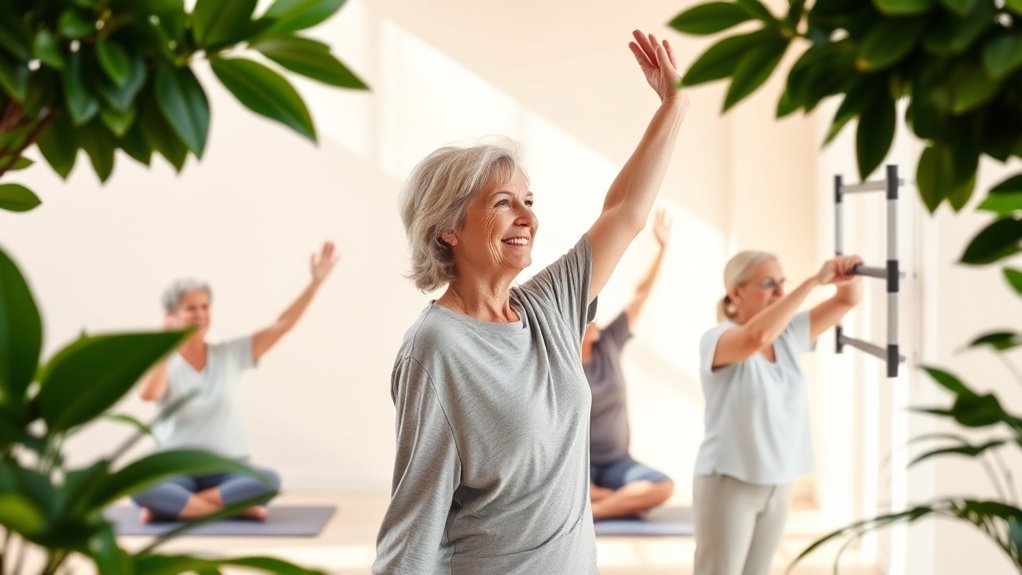
Engaging in Wall Pilates not only boosts your physical fitness but also brings significant mental health benefits.
You’ll find that mindful movement and controlled breathing help reduce stress levels, while the release of endorphins enhances your mood. This connection between body and mind fosters emotional well-being, promoting relaxation and stability. Additionally, the low-impact nature of Wall Pilates sharpens your concentration and cognitive function, which can combat forgetfulness. This practice can be complemented by visualization techniques that enhance your overall experience and alignment with wellness goals. Incorporating low-impact workouts like Wall Pilates can be particularly beneficial for seniors, as they focus on gentle movements that improve stability. Studies show that music therapy can also enhance relaxation during your sessions. Moreover, engaging in regular physical activity is known to improve mental well-being and support emotional health over time. Participating in activities like Wall Pilates can also lead to enhanced cognitive function, which is crucial for maintaining mental acuity as we age.
On the physical side, it enhances flexibility and core strength, reducing the risk of falls. You’ll appreciate the low-impact nature of the workout, easing discomfort in stiff muscles and joints.
Adapting Wall Pilates for Injury Recovery
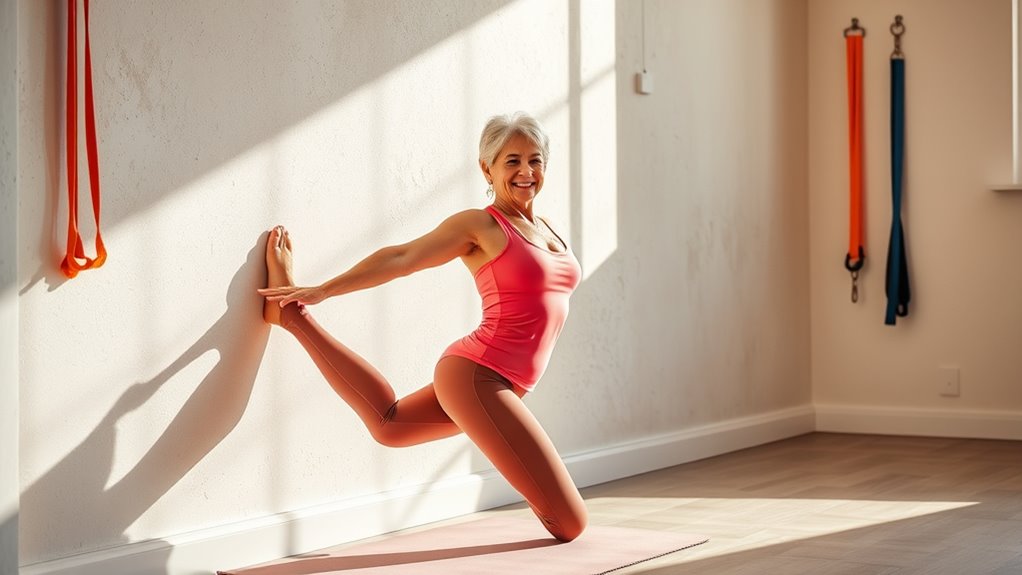
When recovering from an injury, adapting Wall Pilates can be a game changer for your rehabilitation process. This low-impact exercise enhances flexibility and mobility without stressing your joints. Using the wall for stability helps improve your alignment, especially if you have balance issues. Gentle resistance builds core strength and supports pain relief by decompressing joints, making it particularly beneficial for individuals with joint pain. Regular skin treatments can also boost skin health during your recovery process. Understanding narcissistic behavior can also help you mentally navigate the emotional challenges that may arise during recovery. Techniques like the Doorway Stretch and Wall Roll Down can ease tension and improve posture, while Wall Squats and Push-ups strengthen your lower and upper body safely. Additionally, shared experiences during rehabilitation can provide emotional support and connection. Always start slowly, listen to your body, and consider working with an instructor. By focusing on core strength and incorporating mindfulness, you’ll not only recover effectively but also reduce the risk of future injuries.
Incorporating Wall Pilates Into Daily Life

Building on the benefits of adapting Wall Pilates for injury recovery, integrating these exercises into your daily routine can further enhance your overall well-being.
You don’t need much time or space; just find a clear wall and dedicate a few minutes each day. Simple exercises like wall squats, planks, and leg lifts can easily fit into your schedule. The low-impact nature of Wall Pilates makes it perfect for improving strength, flexibility, and balance without the risk of injury. Plus, combining these movements with mindfulness can help reduce stress and boost your mood. Improved strength and flexibility will also contribute to your overall physical performance and daily activities.
Consistency is key, so aim for a few minutes daily, and you’ll notice significant improvements in your physical and mental health.
Frequently Asked Questions
Can Wall Pilates Help With Arthritis Pain Management?
Yes, wall Pilates can help with arthritis pain management.
It improves joint flexibility and mobility, reduces stiffness, and strengthens the muscles around your joints, offering better support. The low-impact nature of wall Pilates minimizes the risk of injury while you exercise.
By incorporating gentle movements, you can enhance your posture and balance, making it easier to perform daily activities.
Practicing regularly can lead to significant improvements in managing arthritis symptoms.
How Often Should Seniors Practice Wall Pilates?
You should aim to practice Wall Pilates at least 2-3 times a week for the best results.
However, feel free to adjust this frequency based on your fitness level and goals. Always listen to your body and take rest days when needed to prevent overexertion.
Combining Wall Pilates with other low-impact exercises can enhance your routine, so explore what works best for you while consulting a healthcare professional before starting any new program.
What Clothing Is Best for Wall Pilates Sessions?
When you’re gearing up for a wall Pilates session, think of your outfit as your trusty armor!
Breathable, stretchy fabrics are your best friends, allowing you to move freely. Opt for moisture-wicking materials to keep sweat at bay, and avoid loose clothing that can trip you up.
Sticky socks or non-slip shoes will anchor you, while comfortable tops and high-waisted pants guarantee you’re both stylish and secure.
Let comfort lead your way!
Are There Any Contraindications for Wall Pilates?
Yes, there are several contraindications for wall Pilates.
If you have chronic health issues like heart conditions or severe musculoskeletal problems, it’s best to consult a healthcare professional first.
Be cautious if you experience balance issues; the wall can offer support.
Avoid exercises that might aggravate joint pain, and modify movements if you’ve had recent injuries.
Always listen to your body and adjust the intensity based on your comfort level.
Can Wall Pilates Be Done With Limited Mobility?
Imagine finding strength in simplicity, where movement feels empowering rather than intimidating.
Yes, you can absolutely practice Wall Pilates with limited mobility. The wall offers stability, allowing you to engage in low-impact exercises that build core strength and improve balance.
You’ll feel more confident and capable as you adapt each exercise to your needs. Start slowly, listen to your body, and embrace this gentle path to fitness that respects your limitations while encouraging progress.
Conclusion
Incorporating Wall Pilates into your routine can be like finding a hidden gem in the vast treasure chest of fitness. It opens doors to improved strength, stability, and posture, making movement feel more fluid and graceful. As you embrace this practice, you’re not just enhancing your physical health; you’re weaving a tapestry of well-being that enriches your mind and spirit too. So, seize the moment, and let Wall Pilates transform your journey toward a healthier, happier you!









